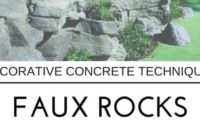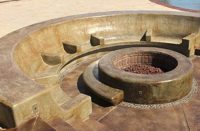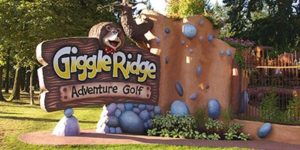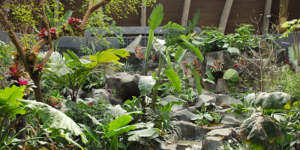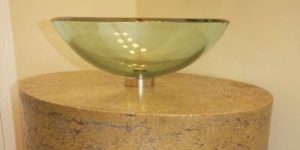With more than 30 years of experience as a professional artist — and a darn good one at that — Thom Hunt has worked his magic at more happy places on Earth than even Walt Disney could have imagined. From the Las Vegas strip casinos and Florida’s extensive theme parks to a rain forest in Costa Rica and a seacoast in Bahrain, the owner of Big Bamboo Studios, in Fairbury, Neb., has created artificial rockwork, water features, landscapes, animals, historical restorations and abstract shapes that stand as a lasting tribute to his myriad talents.
Besides big theme-park names that include Busch Gardens Tampa, Disney World, Universal Studios and SeaWorld, there’s Pennsylvania’s Kennywood, one of the oldest theme parks in the country, where Hunt helped create the Volcano ride. “Just about every zoo or state aquarium you can think of in this country, I’ve had my hand in it as subcontractor or freelance artist,” Hunt says.
He concedes that rockwork and theme work are his bread and butter, but his real passion lies in creating animal sculptures and abstracts. He’s gained the reputation of being the “dinosaur guy,” he says, because he’s done so many of them, including the life-size Acrocanthosaurus he and Mark Whitten, of Mason City, Iowa, constructed during the 2012 Concrete Decor Show. The live workshop and demonstration provided hands-on opportunities for a small crew to help sculpt the dinosaur’s anatomy, achieve key carving details and apply color while attendees watched. The 8,600-pound concrete beast, which Hunt says is one of his all-time favorite sculptures, was donated to the Witte Museum in San Antonio at show’s end.
The early years
In the mid to late ’70s during the summers of his high school freshman through junior years, Hunt was enrolled in a prodigy program to study sculpting at the University of Nebraska-Lincoln. When he graduated high school, he went on to study graphic design at the Minneapolis College of Art and Design. “But I got bored very fast,” he remembers. “So I dropped out and got a job sculpting marble and granite. I wanted to pursue my passion rather than be stuck working on a computer.”
He spent the next several years sculpting out of stone, much of it to adorn cemetery plots, until mass-produced statuary made the job less lucrative.
In the mid ’80s, he landed a job as a sculptor for Tucson, Ariz.-based Larson Co., which would become a world leader in the creation of simulated environments. His first concrete gig involved making signage for Busch Gardens Tampa’s “Land of the Dragons.”
“I liked working with concrete because it was so forgiving,” Hunt says. Unlike with marble, if something broke off, he could fix it.
While employed by Larson, he traveled the world and helped build aquariums and zoos, including the “Passages of the Deep” exhibit at the Oregon Coast Aquarium in Newport, the Downtown Aquarium in Denver, Colo., and the interactive animal sculptures at Tisch Children’s Zoo in New York City’s Central Park.
The Denver aquarium, which was originally called Colorado’s Ocean Journey, was probably the most challenging project he’s ever worked on, Hunt says. One half of the exhibit, which explores the relationship between inland freshwater ecosystems and the ocean, begins at a replica of the snowcapped Rocky Mountains, “which I built,” he says. “I was there for over a year and the last person from the company to leave. There wasn’t one exhibit fabricated out of concrete there I didn’t touch.”
Growth and giving back
In 1998, after finishing up at the South Carolina Aquarium in Charleston, Hunt and his oldest son, Jamie, headed back home to Tucson, where Hunt founded Big Bamboo Studios. The first three years, their work mainly consisted of sculpting more than 100 water features for a large pool company in Tucson. Then Hunt changed the company’s direction.
“We were building so many waterfalls that I had to hire and pay a lot of people,” he says, and consequently he was not making much profit. “So we downsized and started looking for larger jobs,” such as the Museum of Natural History at Morro Bay State Park in California. Before long, Larson started subcontracting with his company to handle projects ranging from the McKinley Chalet Resort in Alaska to the Bass Pro Shops in Bossier City, La.
“Our business started growing as the word of mouth got out,” Hunt says. It continues to flourish without the aid of a structured marketing program, he says. “Even to this day, I don’t advertise and I don’t look for work. The work comes to me.”
Today Big Bamboo’s home office is in Fairbury, Neb. The company also recently opened a new gallery about 50 miles away in Pawnee City, Neb.
Company principals consist of Hunt and three other artists, along with a conglomerate of freelance artists from around the country, who juggle a busy schedule filled with water parks, elaborate swimming pools for private residences, extensive sculpture work and specialty projects.
Hunt says he also conducts on-site training sessions, such as going to a zoo and teaching the staff how to patch and repaint deteriorating exhibits instead of hiring someone else to do it for them. This summer, he has an engagement in Costa Rica where he’ll teach groundskeepers of a 27-acre rain forest garden how to sculpt artificial trees to be part of a public exhibit. An earlier project in the garden involved erecting a retaining wall that features two large concrete trees supporting “mystical” doors leading into an embankment.
Two years ago, Hunt began teaching classes at his Fairbury location that mainly center on rockwork and trees. “They’re for people in decorative concrete who want to diversify from floors and walls,” he says. Currently, he plans to offer them on demand.
Hunt is also tinkering with an idea involving a curriculum that would introduce high-school and college students interested in pursuing a decorative concrete career to some of the larger decorative concrete companies. “That’s why I bought the old Carnegie Public Library in Pawnee City. I’d like to hold the classes downstairs,” says the father of six, who admits he has a soft spot in his heart for kids.
In fact, Hunt makes it his business to donate his services to a worthy children’s organization each year. “It’s my way of giving back to the community,” he says. Last year, for instance, he teamed up with Jody Smith to create an exhibit for the Children’s Museum of the Lowcountry, in Charleston. The exhibit traces the process of how rain travels through the waterways until it’s used to irrigate fields.
Rock-solid advice
A sculptor, painter and designer, Hunt says his attention to detail is what helps make his work so memorable. “When I do a dinosaur, I research extensively to find out everything known about the beast, from how long the fingers were to the curvature of the claws,” he says. “I live by my saying: ‘Perfect is not good enough.’ Which makes me pretty hard to work for but is good for my reputation.”
He advises you to take a lot of pictures of work you’re proud of so that when you are courting new business, you’ll “go in there with your guns loaded.”
Finally, Hunt tells contractors who are just breaking into the business to have patience. “You can’t just jump in and do something well,” he says. “It takes lot of practice. Don’t try to copy someone else’s work. Be unique. Just do your own thing and don’t worry about the other guy.”
www.bigbamboostudios.com
www.ratinternational.org

